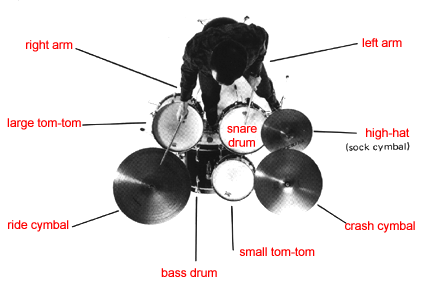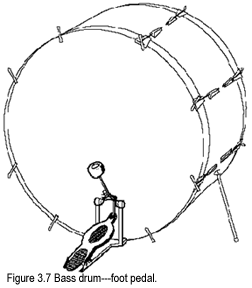Excerpted from chapter 3: Appreciating Jazz Improvisation
The drummer uses his right hand to play rhythms which provide both regular pulse and swing feeling. These rhythms are played on a cymbal suspended on the right side over the drum set (see Figures 3.3 and 3.4). Such a cymbal comes to occupy the role of ride cymbal if it is capable of producing a certain quality of “ping” and its sound sustains properly. The timekeeping rhythms played on it are called ride rhythms. Occasionally they consist of one stroke per beat (ching, ching, ching, ching) , played in unison with the walking bass. But they are usually more complicated, for example, ching chick a ching chick a ching chick a ching , OR , ching ching ching chick a ching OR ching chick a ching chick a ching chick a chick a ching, etc. (See page 430 for notations.) The drummer may play ride rhythms on other parts of his set, too. In fact, before the ride cymbal came into common use, ride rhythms were played on the snare drum and high-hat cymbals. Note also that the drummer might play ride rhythms on another cymbal suspended to his left, and the drummer’s right hand is not limited to playing the ride cymbal. He can use it to play any of his instruments. The ride cymbal just gets more of its attention.
Click on parts of the drum set below to hear audio excerpts from the
Jazz Styles: History and Analysis Demonstration Compact Disc.
(Please expect minor delays while the audio clips are being downloaded.)

Audio Clips Copyright 1988 Prentice-Hall, Inc. Reproduction Prohibited.
Drummers frequently interrupt timekeeping patterns to make other, more colorful sounds. The crash cymbal is often struck by the drummer’s right hand, after a fill, while ride rhythms are interrupted. By comparison with the ride cymbal, the crash cymbal makes a splashier tone color, and its sound disappears more quickly. (Ride and crash cymbal sounds are compared on the Jazz Styles Demonstration CD track 4. They are abundant in the drumming of Elvin Jones on “The Promise” and Tony Williams on “Masqualero” in the Jazz Classics CDs.) Other colorations can be extracted from the small tom tom , suspended over the bass drum, and the large tom tom, sitting on the floor to the player’s right. (See Figures 3.3 and 3.4, and listen to tom toms on the Jazz Styles Demonstration CD tracks 6 and 7.)
The drummer’s left hand is free to accent and color the group sound by striking his snare drum, on a stand close to his lap (see Figure 3.4). The snare drum has a crisp, crackling sound. The sounds made by striking the snare drum are often called “fills” because they fill in a musical gap left by the soloist. In addition to “fills,” the snare drum is used to provide an undercurrent of activity that seems to be “chattering” while the band is playing. (Listen to the narrated demonstration on the Jazz Styles Demonstration CD tracks 5, 8, 31 and 32. Then listen for these sounds from Roy Haynes on “Steps” in the Jazz Classics CDs.)
 Accentuating the swing feeling achieved by the bassist’s emphasis of the second and fourth beats in each measure, the drummer plays those same beats by pressing his left foot on a pedal which closes two cymbals together, making a “chick” sound. This apparatus is called a high-hat or sock cymbal . (See Figure 3.5, and listen to the Jazz Styles Demonstration CD.) The high-hat will produce a “chick” sound if the pedal is depressed and held in closed position for a second. It can then be opened and closed again for another “chick” sound. A “ching” sound can be achieved by bringing the cymbals together just long enough for them to strike each other then releasing them to resonate. All this is done by means of the high-hat’s foot pedal. Sounds can also be extracted from the high-hat by sticks, wire brushes, or mallets. Each implement produces different sounds (see Figure 3.6). The high-hat cymbals can be struck when they are closed or open. Each cymbal in the unit can also be struck independently. Any part of any cymbal can be struck; each part produces a different sound (demonstrated on the Jazz Styles Demonstration CD).
Accentuating the swing feeling achieved by the bassist’s emphasis of the second and fourth beats in each measure, the drummer plays those same beats by pressing his left foot on a pedal which closes two cymbals together, making a “chick” sound. This apparatus is called a high-hat or sock cymbal . (See Figure 3.5, and listen to the Jazz Styles Demonstration CD.) The high-hat will produce a “chick” sound if the pedal is depressed and held in closed position for a second. It can then be opened and closed again for another “chick” sound. A “ching” sound can be achieved by bringing the cymbals together just long enough for them to strike each other then releasing them to resonate. All this is done by means of the high-hat’s foot pedal. Sounds can also be extracted from the high-hat by sticks, wire brushes, or mallets. Each implement produces different sounds (see Figure 3.6). The high-hat cymbals can be struck when they are closed or open. Each cymbal in the unit can also be struck independently. Any part of any cymbal can be struck; each part produces a different sound (demonstrated on the Jazz Styles Demonstration CD).
The drummer uses his right foot to press a pedal which, in turn, causes a mallet to strike the bass drum (see Figure 3.7). The drummer sometimes plays the bass drum lightly on every beat, and he also uses it for accents.